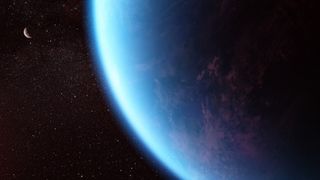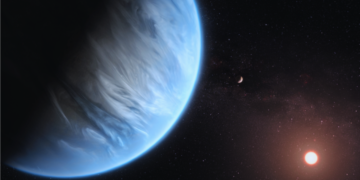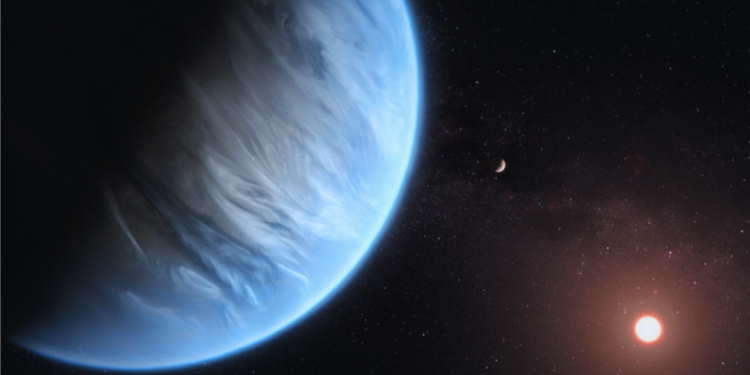News of life beyond Earth ignited a spark of excitement last year, fueled by the James Webb Space Telescope’s (JWST) observations of the exoplanet K2-18b. However, a recent study by the University of California Riverside (UCR) throws a bucket of cautionary water on those initial reports. While the search for extraterrestrial life continues, the jury’s still out on definitive signs on K2-18b.
A Tantalizing Target: K2-18b – An Earth-like Ocean World
K2-18b captured astronomers’ attention for a reason. This “super-Earth,” roughly double the size of our planet, resides in its star’s habitable zone, a region where liquid water, a key ingredient for life as we know it, could potentially exist. Unlike Earth, K2-18b likely boasts a vast ocean beneath a hydrogen-rich atmosphere. This unique composition places K2-18b in the category of hycean worlds – a relatively new class of exoplanets that astronomers are eager to study in detail.
Initial Hope: Signs of Carbon Dioxide, Methane, and Maybe Even Life?
The JWST’s initial investigation in 2023 yielded promising results. Scientists detected the presence of carbon dioxide and methane in the exoplanet’s atmosphere, suggesting a hycean world – one dominated by liquid water. But the real excitement stemmed from a potential biosignature – the tentative detection of dimethyl sulfide (DMS). On Earth, DMS is produced by ocean phytoplankton, microscopic organisms that release this gas as part of their biological processes. The presence of DMS on K2-18b would have hinted at the existence of similar life forms, making this exoplanet a top contender in the search for extraterrestrial life.
A Sobering Second Look: Re-evaluating the DMS Signal
The positive spin on the DMS finding, however, proved premature. The UCR team, led by astrobiologist Eddie Schwieterman, revisited the data. Their computer models, accounting for the hydrogen-heavy atmosphere and the properties of DMS, suggested the original signal wasn’t strong enough to definitively confirm its presence. Methane, another molecule detected by JWST, could be mimicking the DMS signature, making differentiation a challenge for the current instrument.
The Search Continues: New Strategies and Future Observations
This doesn’t spell doom and gloom for the search for life on K2-18b. The JWST continues its observations, with the MIRI (Mid-Infrared Instrument) now taking center stage. This instrument is specifically designed to detect light in the mid-infrared range, which is often better suited for analyzing the atmospheres of exoplanets. By collecting more data with MIRI, scientists hope to get a clearer picture of the exoplanet’s atmospheric composition and potentially tease out the presence of other biosignatures that might be more readily distinguishable from background noise.
Looking Beyond Earth-like Biosignatures
The search for life beyond Earth expands beyond simply mirroring Earth’s conditions. Schwieterman highlights the importance of considering biosignatures unique to planets with different atmospheric compositions. On K2-18b, for instance, DMS might be a more prominent biosignature than oxygen, produced by Earth’s plant life. This highlights the need for a broader approach to biosignature detection, taking into account the varied chemical processes that life could utilize across the vast expanse of the universe.
A Stepping Stone on the Path to Discovery
While the initial excitement about life on K2-18b might need tempering, the research is far from a setback. It underscores the complexity of exoplanet atmospheres and the challenges in identifying definitive biosignatures. The JWST’s observations, despite the uncertainty surrounding DMS, represent a significant step forward in our understanding of hycean worlds – prime targets in the hunt for extraterrestrial life. K2-18b serves as a stepping stone on this path of discovery, demonstrating the capabilities of the JWST and paving the way for future observations of not only this intriguing exoplanet but also countless others waiting to be explored.
The Enduring Human Drive to Explore

As Tsai aptly points out, our search for life in the cosmos is akin to exploring the unknown at night. We instinctively seek light to illuminate what lies beyond the darkness. The quest for life beyond Earth continues, fueled by unwavering curiosity and the ever-evolving tools at our disposal. The universe holds countless secrets, and K2-18b might just be one chapter in this ongoing story of discovery. The JWST, with its powerful gaze, is helping us turn the pages of this cosmic narrative, and future missions and instruments promise to reveal even more in the years to come.



















